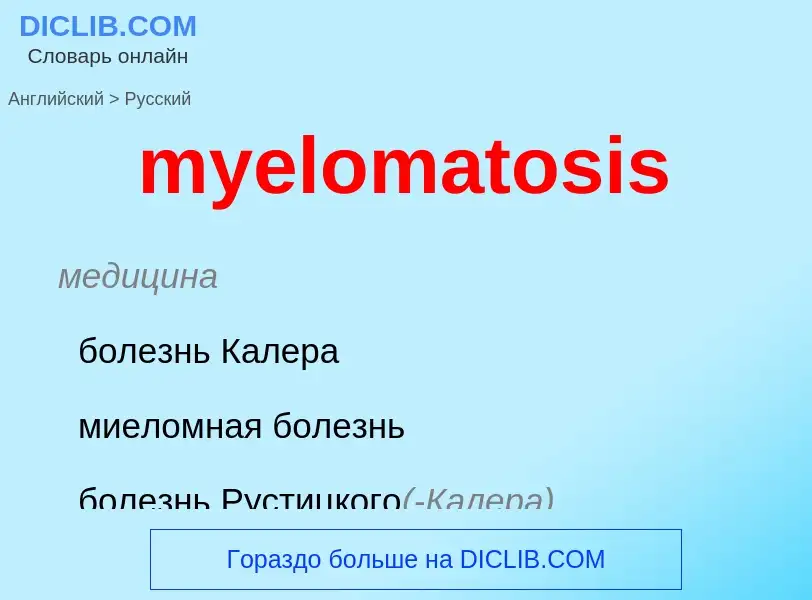Tradução e análise de palavras por inteligência artificial ChatGPT
Nesta página você pode obter uma análise detalhada de uma palavra ou frase, produzida usando a melhor tecnologia de inteligência artificial até o momento:
- como a palavra é usada
- frequência de uso
- é usado com mais frequência na fala oral ou escrita
- opções de tradução de palavras
- exemplos de uso (várias frases com tradução)
- etimologia
myelomatosis - tradução para russo
медицина
болезнь Калера
миеломная болезнь
болезнь Рустицкого(-Калера)
множественная миелома
плазмома
миелогенная псевдолейкемия
медицина
миелома
медицина
миеломная почка
Definição
Wikipédia

Multiple myeloma (MM), also known as plasma cell myeloma and simply myeloma, is a cancer of plasma cells, a type of white blood cell that normally produces antibodies. Often, no symptoms are noticed initially. As it progresses, bone pain, anemia, kidney dysfunction, and infections may occur. Complications may include amyloidosis.
The cause of multiple myeloma is unknown. Risk factors include obesity, radiation exposure, family history, and certain chemicals. There is an increased risk of multiple myeloma in certain occupations. This is due to the occupational exposure to aromatic hydrocarbon solvents having a role in causation of multiple myeloma. Multiple myeloma may develop from monoclonal gammopathy of undetermined significance that progresses to smoldering myeloma. The abnormal plasma cells produce abnormal antibodies, which can cause kidney problems and overly thick blood. The plasma cells can also form a mass in the bone marrow or soft tissue. When one tumor is present, it is called a plasmacytoma; more than one is called multiple myeloma. Multiple myeloma is diagnosed based on blood or urine tests finding abnormal antibodies, bone marrow biopsy finding cancerous plasma cells, and medical imaging finding bone lesions. Another common finding is high blood calcium levels.
Multiple myeloma is considered treatable, but generally incurable. Remissions may be brought about with steroids, chemotherapy, targeted therapy, and stem cell transplant. Bisphosphonates and radiation therapy are sometimes used to reduce pain from bone lesions.
Globally, multiple myeloma affected 488,000 people and resulted in 101,100 deaths in 2015. In the United States, it develops in 6.5 per 100,000 people per year and 0.7% of people are affected at some point in their lives. It usually occurs around the age of 60 and is more common in men than women. It is uncommon before the age of 40. Without treatment, the median survival in the prechemotherapy era was about 7 months. After the introduction of chemotherapy, prognosis improved significantly with a median survival of 24 to 30 months and a 10-year survival rate of 3%. Even further improvements in prognosis have occurred because of the introduction of newer biologic therapies and better salvage options, with median survivals now exceeding 60 to 90 months. With current treatments, survival is usually 4–5 years. The five-year survival rate is about 54%. The word myeloma is from the Greek myelo- meaning "marrow" and -oma meaning "tumor".



![protein electropherogram]] showing a paraprotein (peak in the gamma zone) in a person with multiple myeloma protein electropherogram]] showing a paraprotein (peak in the gamma zone) in a person with multiple myeloma](https://commons.wikimedia.org/wiki/Special:FilePath/Monoclonal gammopathy Multiple Myeloma.png?width=200)
![Plasmablast, [[Wright stain]], in a case of multiple myeloma of plasmablastic type. Plasmablast, [[Wright stain]], in a case of multiple myeloma of plasmablastic type.](https://commons.wikimedia.org/wiki/Special:FilePath/Plasmablast, Wright stain.png?width=200)
![Bone marrow aspirate showing the histologic correlate of multiple myeloma under the microscope, [[H&E stain]] Bone marrow aspirate showing the histologic correlate of multiple myeloma under the microscope, [[H&E stain]]](https://commons.wikimedia.org/wiki/Special:FilePath/Multiple myeloma (2) HE stain.jpg?width=200)

![[[Micrograph]] showing myeloma [[cast nephropathy]] in a [[kidney biopsy]]: Hyaline casts are PAS positive (dark pink/red – right of image). Myelomatous casts are PAS negative (pale pink – left of image), [[PAS stain]]. [[Micrograph]] showing myeloma [[cast nephropathy]] in a [[kidney biopsy]]: Hyaline casts are PAS positive (dark pink/red – right of image). Myelomatous casts are PAS negative (pale pink – left of image), [[PAS stain]].](https://commons.wikimedia.org/wiki/Special:FilePath/Cast nephropathy - 2 cropped - very high mag.jpg?width=200)

![[[Micrograph]] of a [[plasmacytoma]], [[H&E stain]] [[Micrograph]] of a [[plasmacytoma]], [[H&E stain]]](https://commons.wikimedia.org/wiki/Special:FilePath/Plasmacytoma_ultramini1.jpg?width=200)



![CT scan of the lower vertebral column in a man with multiple myeloma, showing multiple osteoblastic lesions: These are more [[radiodense]] (brighter in this image) than the surrounding [[cancellous bone]], in contrast to osteolytic lesions, which are less radiodense. CT scan of the lower vertebral column in a man with multiple myeloma, showing multiple osteoblastic lesions: These are more [[radiodense]] (brighter in this image) than the surrounding [[cancellous bone]], in contrast to osteolytic lesions, which are less radiodense.](https://commons.wikimedia.org/wiki/Special:FilePath/CT of osteoblastic lesions of multiple myeloma.jpg?width=200)
![[[Femur]] with multiple myeloma lesions [[Femur]] with multiple myeloma lesions](https://commons.wikimedia.org/wiki/Special:FilePath/Left femur with myeloma.jpg?width=200)

![[[Humerus]] with multiple myeloma lesions [[Humerus]] with multiple myeloma lesions](https://commons.wikimedia.org/wiki/Special:FilePath/Left humerus with myeloma.jpg?width=200)

